Final Exam Micro W2-5 - MGMT
1/38
There's no tags or description
Looks like no tags are added yet.
Name | Mastery | Learn | Test | Matching | Spaced |
|---|
No study sessions yet.
39 Terms
Perception
The process of organising and interpreting sensory data to make sense of your position in your environment
Three key components = perceiver, situation and target
Perception is something that we generally do automatically and not something we really think consciously about.
Impacts our cognitive and emotional responses. Our perception informs what we call "Social Cognition"
Limits of Perception
Fundamental attribution error: attribute another's actions to their character, personality, or external factors outside of their control
Self-serving bias: attribute positive outcomes and successes to internal factors like our personal traits, skills, or actions
Cultural differences: favour one culture over others
Our Theory of Mind
We need to have our own conception of how other people think and how their thoughts influence their behaviour
not independent of our culture and experience
Self-perception
Unskilled and unaware of it - "The Double-Curse" (bias in self-perception)
The less skilled and knowledgeable we are, the less likely we are to recognise our deficiencies
Attribution
Attribution Theory is concerned with how individuals perceive the information they receive, interpret events, and how these form causal judgements
Humans are “intentional”— (1) our consciousness is directed at things beyond the limits of our physical body; and, (2) we do things for a reason or a purpose (i.e., behaviour has motivations).
Fundamental Attribution Error (FAE) is a tendency to see the person rather than the situation as the main cause of that person’s behaviour.
Self-Serving Attribution Errors
The self-serving nature of attribution errors:
We tend to attribute our successes to internal factors and our failures to external factors
Conversely, we tend to attribute the successes of others to external factors and their failures to internal factors
Biases and other sources of error in decision making: stereotyping, confirmation bias, the halo effect, anchoring (comparing with our first experience), lookism, etc.
e.g:
Recruitment & Selection – Interviews (when used alone) are a poor predictor of performance but we still heavily rely on them.
Performance Management – we tend to overestimate the performance of above average performers and underestimate the performance of below average performers.
Strategy – many biases are at play in making plans about the future (especially anchoring, confirmation, escalation, & the “ostrich” effect)
Decision Making
Individuals can never make decisions on a truly rational basis as they have limited information processing capabilities (Herbert Simon)
Bounded Rationality
Decision-making is always a social process.
All decisions are arrived at using a combination of “facts” and values that have social origins.
We are thus acting on incomplete information that exists in a social context and our biases then further shape the conclusions we draw.
Different types of decision making rules
Heuristics = “rules of thumb”, short cuts or institutionalised decision rules (e.g., crossing the road).
Formal decision-making rules (e.g., “first look left, then look right”).
Experiential decision-making rules (e.g., how fast traffic travels).
Culturally-based decision-making rules (e.g., Do other road users obey the rules?; “jay-walking,”
Importance of Heuristics
When trusting our "gut instinct" we are combining formal and experiential knowledge
When heuristics are shared they become taken-for-granted - "the way we do things around here"
The influence of Group Membership:
Social interactions help acquire beliefs, attitudes, values, and characteristic behaviours
Who we associate with has crucial impact on our sense of identity
Creates social setting where we can exert influence on others (e.g demonstration, exhortation, coercion, bribery, etc.)
Satisfies important needs (social affiliation, common purpose, recognition)
Formal and Informal Groups
Groups are important in OB because they are ubiquitous in organisations
In organisations, teams are formal groups intentionally created to achieve an objective set by the organisation
BUT informal groups can also emerge spontaneously and reflect the common interests of their members
Sometime the objectives of informal groups may not align with those of the organisation
Group Dynamics
The "strength" of the interaction depends on the nature of common objective, the context, and the social skills of group members
Team Effectiveness Model

Team Design & The Discipline of Teams


Team States
Norms: Do we have a shared understanding of how to work together?
Cohesion: Do we identify with the team? What’s the quality of relationships?
Team efficacy: Do we believe we can accomplish the task?
Trust: Can we rely on each other? Is it safe to experiment and take risks?
The process of team development
Teams are dynamic social settings – they form and disband; membership changes
Team values and behavioural norms need to be established quickly and be taught to new members
When working in teams, be aware of your own perceptual process and try to identify shortcuts in forming opinions and ideas relative to your team members.
Tuckman's Model of Team Development
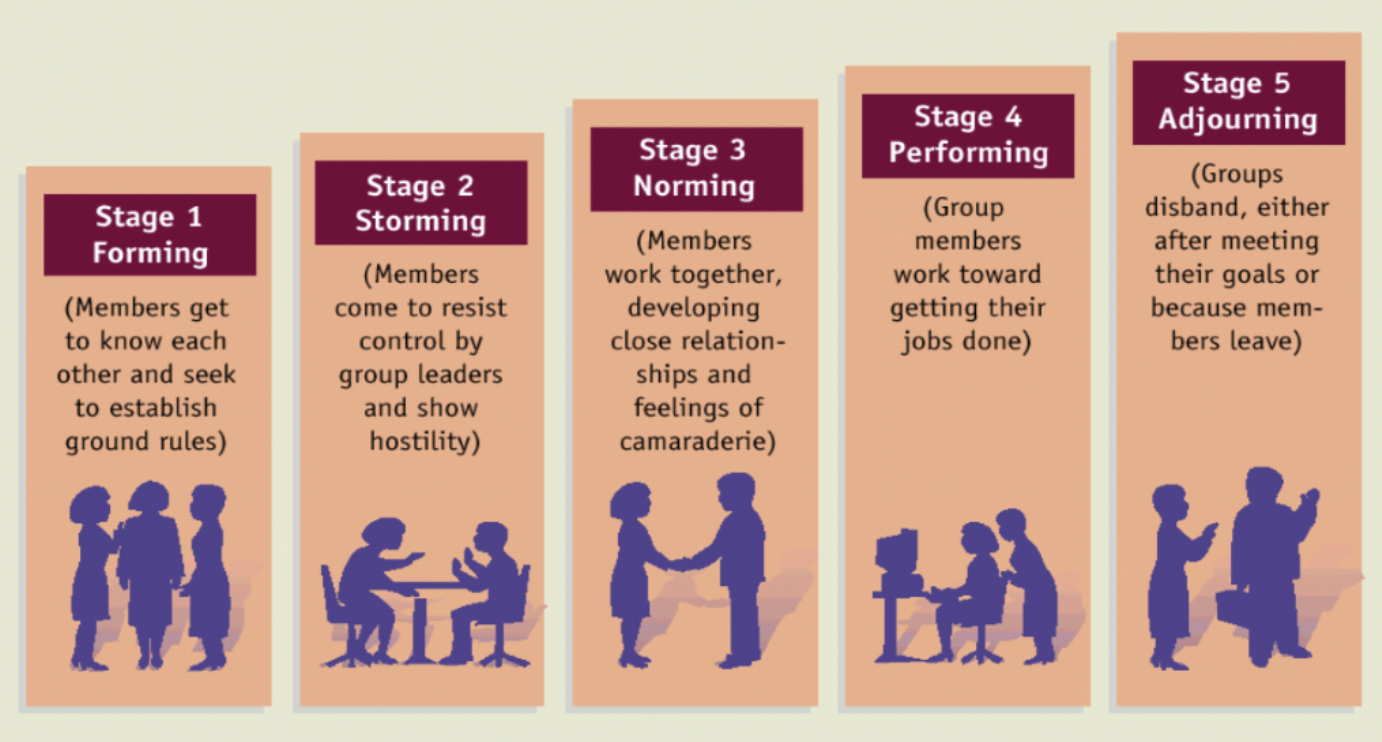
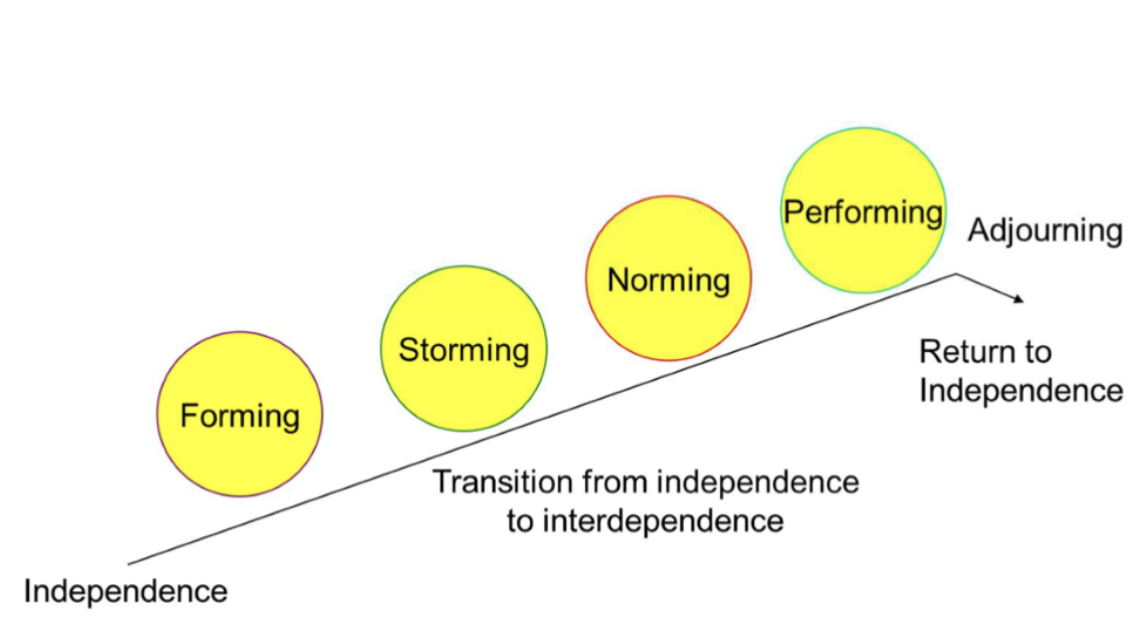
describes the stages that teams typically go through as they form and evolve toward becoming effective and high-performing.
Gersick's Punctuated Equilibrium Model
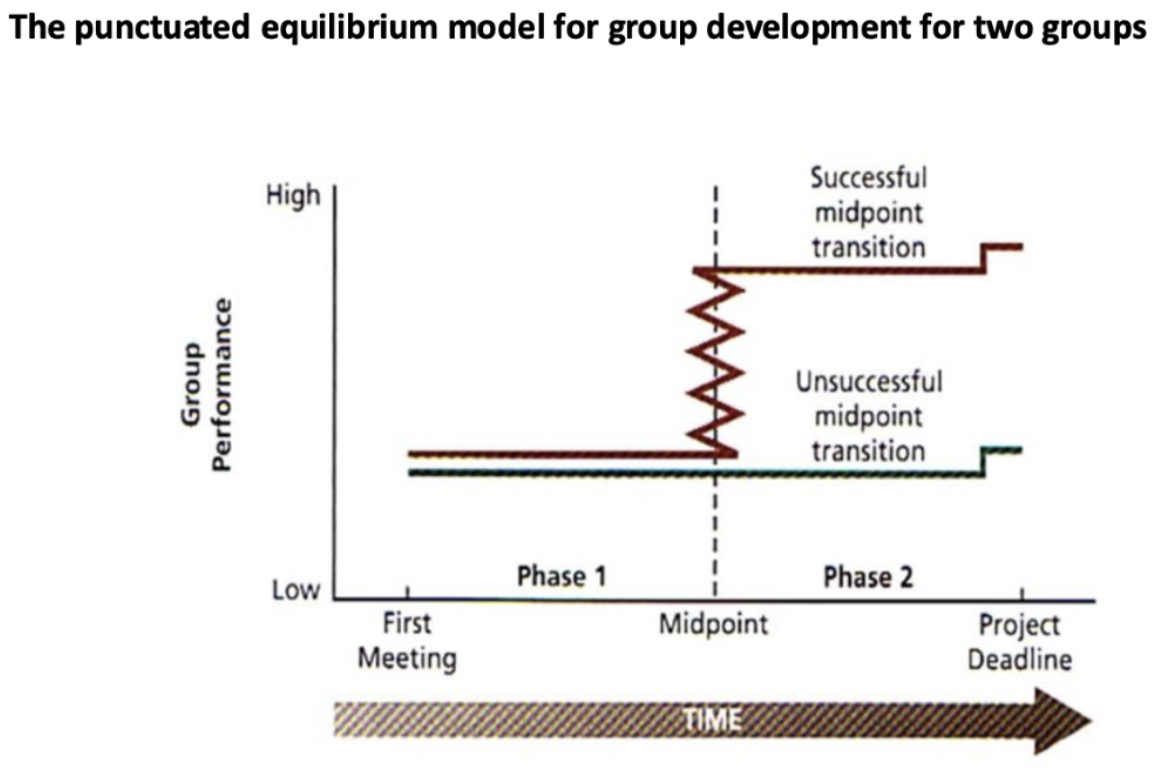
describes how teams working under a deadline develop over time—not in smooth, gradual stages, but through periods of stability interrupted by sudden change.
Team "Spirit" (Heerman)
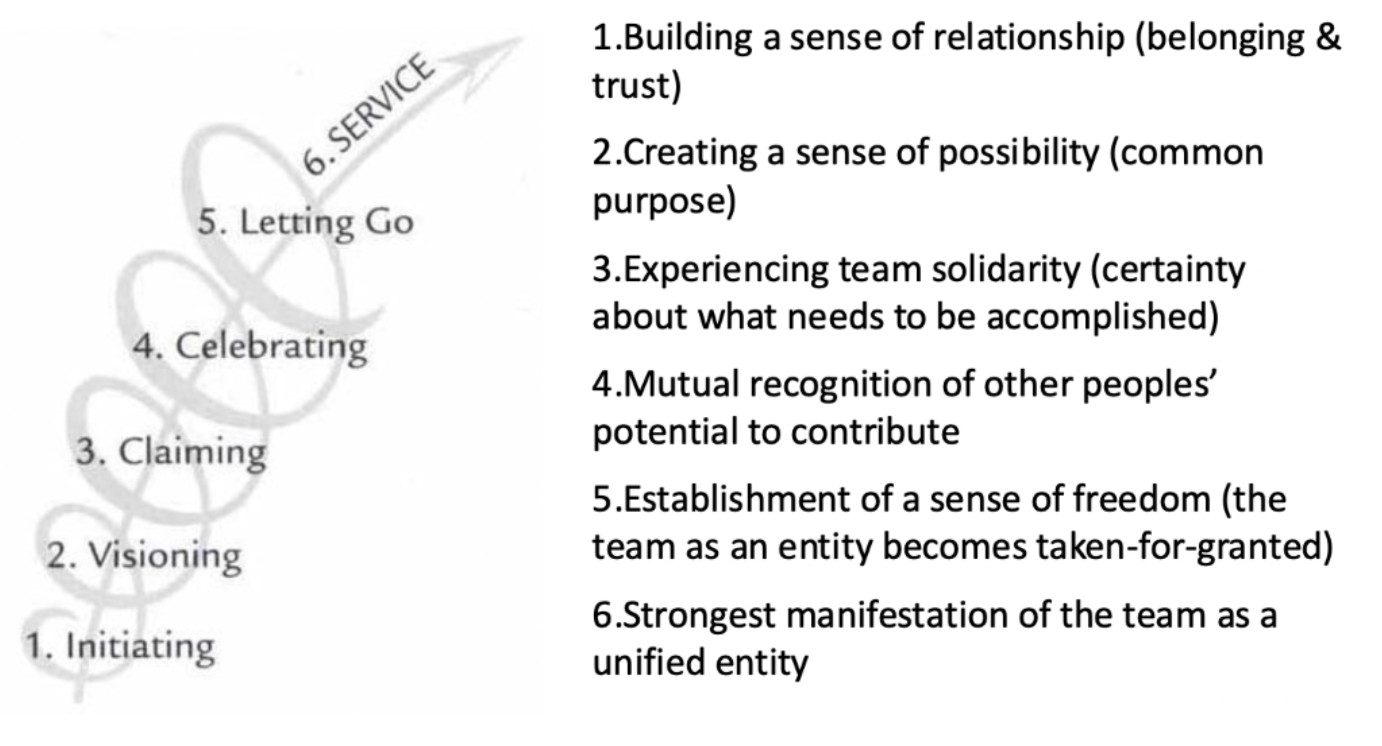
describes team development as an evolving spiral rather than a straight line.
Group Dynamics: Task & Maintenance
Maintenance (or process): activities where the team is working on its own internal processes and focuses its efforts on establishing a common purpose and effectiveness
Task: activities where the team focuses its efforts on the job at hand
Downsides of Teamwork
"Groupthink"
Social loafing (procrastinating the actual work is talking about something else)
Free-riding – the "Ringelmann effect" (taking advantage of other people's efforts, the tendency of individual members of a group to become increasingly less productive as the group size increases.)
Cultural differences - "individualism" vs "collectivism"
Stereotyped views of outsiders (enemies)
Groupthink
when the desire for harmony or conformity in the group results in irrational or dysfunctional decision-making outcomes.
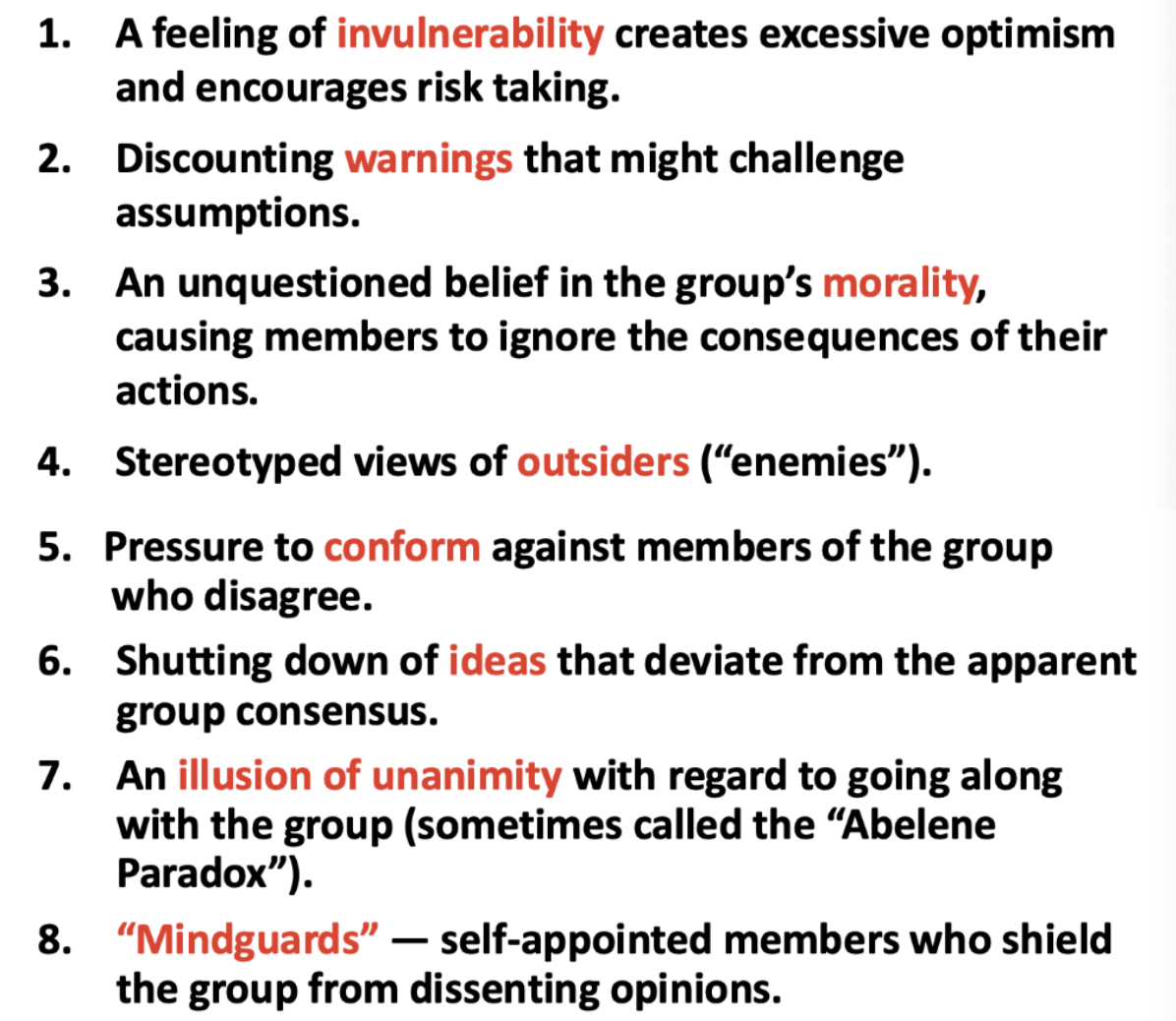
Leadership in Teams / Distributed Leadership
Different kinds of teams require different kinds of leadership at different times.
4 types of leadership that must be exercised for a successful team:
ENVISIONING – Creating a strong vision of the purpose of the team that can easily be translated into a set of values (maintenance).
ORGANISING – Providing structure through a focus on details, deadlines, and structures (task & maintenance).
SPANNING – Networking, gathering information, championing the team in the rest of the organisation, dealing with outsiders, preventing the team from becoming isolated, etc.; importantly, the spanning leader may have to coordinate the team’s activities with the rest of the organisation (task & maintenance).
SOCIAL - Negotiation, conflict resolution, “surfacing” problems, confronting anti-social behaviour (maintenance).
Values
Values are enduring personal beliefs about what is important or valuable
Expression of the “right way” to behave to support a preferred set of social arrangements (e.g. social or moral values such as honesty, fairness, kindness, justice, etc.)
Values can be characterised in terms of their:
- Intensity (e.g. level of significance / endurance)
- As a result, there may be a hierarchy of values
- Content (e.g., terminal or instrumental values)
Values to Attitudes
Values:
Provide the normative basis for attitudes (i.e., criteria against which we judge the object, person or event and form an attitude about it)
Values can, however, be in conflict (kindness vs honesty; fairness vs justice; truth vs a ”Greater” cause)
Attitudes:
Evaluative statement about an object, person or event
A persistent tendency to feel and behave in a particular way towards
something
Attitudes are characterised by their persistence, valance and direction
Attitudes to Behaviours

Practical impact of Attitudes
Employee attitudes can be changed , but there can be barriers to changing our attitudes such as:
- prior commitments (formal knowledge/informal knowledge)
- Cognitive Biases / prejudice
- insufficient information
There are ways to change attitudes such as:
- providing more information (but what about dis/misinformation?)
- involving dissatisfied people to improve the situation (negotiation)
- Persuasion and manipulation
Job Satisfaction: A multidimensional attitude
A positive emotional response resulting from the appraisal of one’s job or job experience
Influenced by personal values (e.g., autonomy, money, competence, social interaction, etc.)
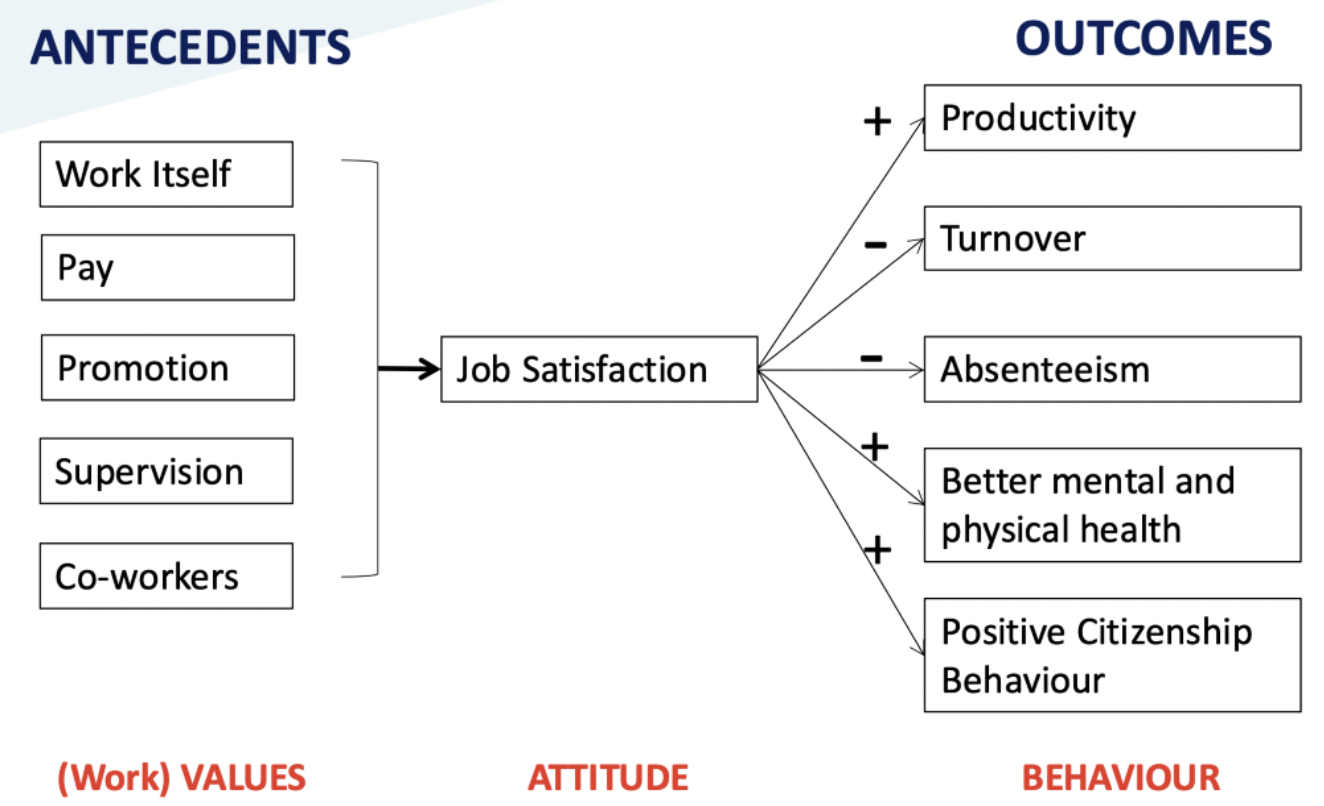
Organisational culture: shares values, attitudes, behaviours
Definition: A system of shared values, beliefs, and behaviours guiding how people behave in an organisation.
Key Features:
Exists at group (not individual) level
Acts as the “glue” that holds an organisation together
Shapes decision-making, interaction, and communication
Becomes a culture when shared by many over time
Exists across levels: team, department, organisation, nation
Is historical, stable, normative, and tied to identity
What is motivation & Why is motivation important
The degree of effort and persistence directed towards a goal
Humans are intentional beings: Our minds are directed toward goals and external matters.
Relevance: Central to fields like business ethics, law, and economics.
Motivation theories: Underpin organisational interventions aimed at promoting desirable behaviours and discouraging undesirable ones.
Maslow's Need Hierarchy
Human actions are driven by universal needs
Needs cluster into five categories (e.g. Maslow's Hierarchy)
Progression principle: We pursue unmet needs, and once satisfied, move to the next level
Needs are arranged in a hierarchy of importance, from basic to more advanced needs
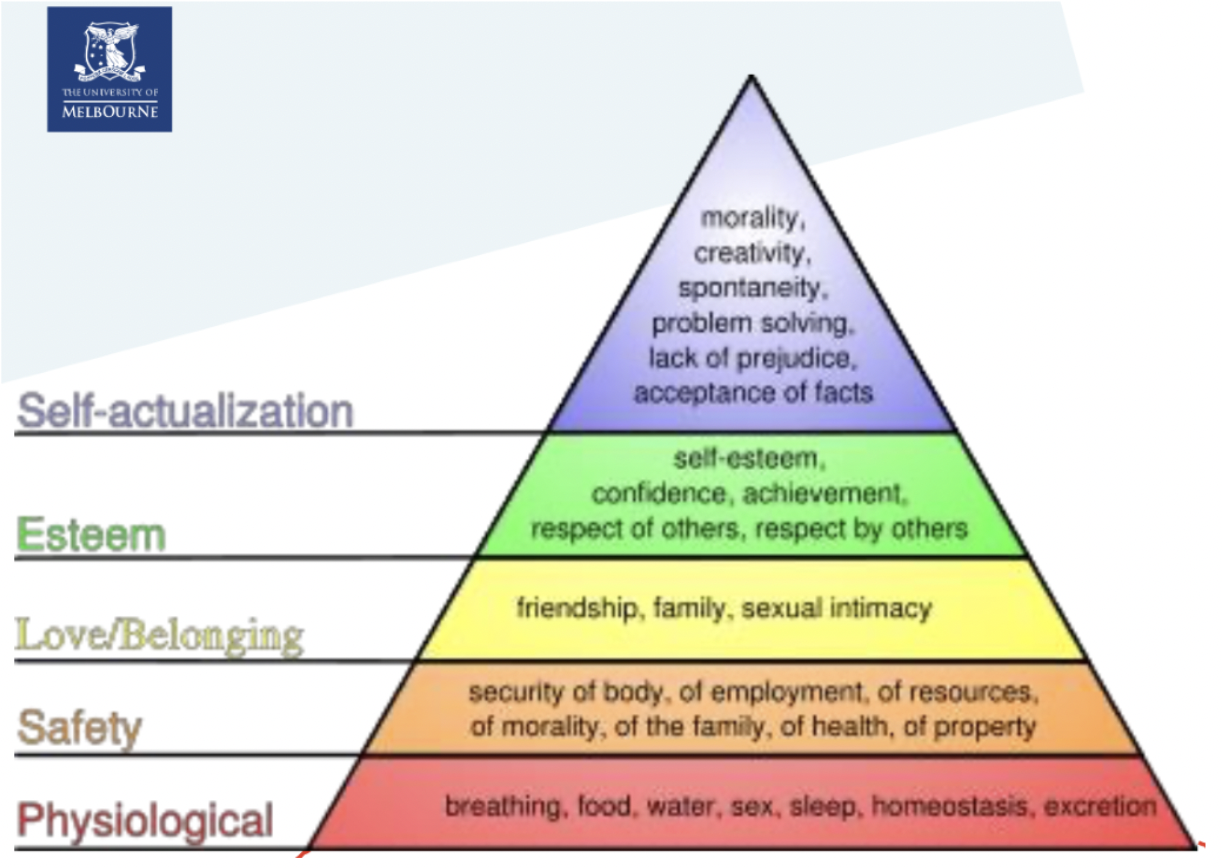
Content theories don’t fully explain the complexities of what motivates people at work.
'Learned' or 'Acquired' Needs Model
People vary in their needs for:
• Achievement (Individual responsibility; challenging but achievable goals; clear feedback)
• Affiliation (Interpersonal relationships; opportunities to communicate; desire social approval, avoid conflict, support others)
• Power (exercise control over environment and others; benefit themselves or group; seek leadership)
Process Theories of Motivation - Expectancy Theory (Vroom)
Motivation = Expectation of results
People are motivated when they:
Like the task
Believe they can succeed
Value the reward
Low motivation if reward is unappealing or goal seems unachievable
People value different outcomes (e.g. pay vs. job security)
Asymmetry challenge: Motivation varies because people perceive value and success differently
Effective Motivational force
EP x PO x V
EP = expectancy that extra effort will lead to improved performance
PO = belief that improved performance will lead to a positive outcome (instrumentality)
V = valence (i.e., desirability) for the individual of the expected outcome
Equity Theory (Adams)
Motivation comes from fairness in effort vs. reward
People compare their input/output ratio to others in similar roles
Perceived inequity (e.g. unequal pay) can reduce motivation
Aim: maintain a balanced, fair exchange in the workplace
Perceived Inequity
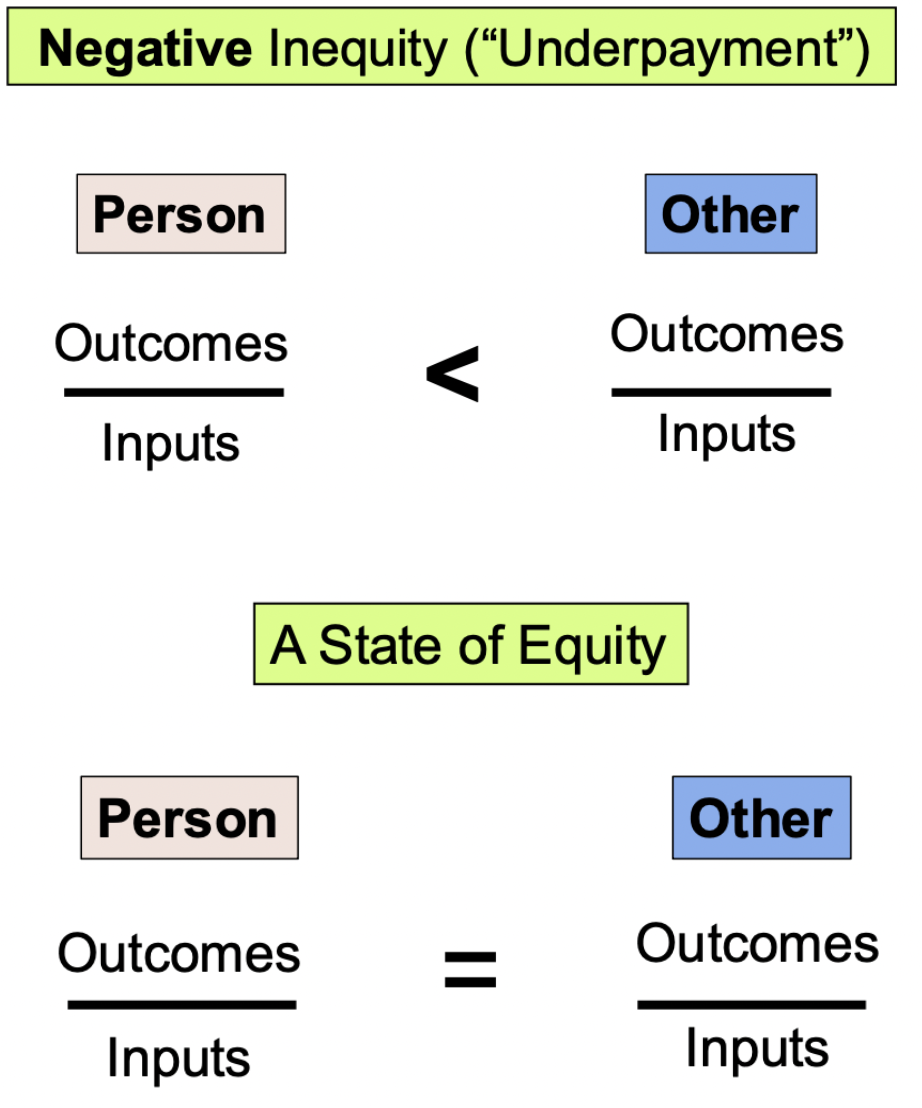
Response to Perceived Inequity

People may misjudge effort or rewards (self or others)
Often compare themselves to peers
Responses include:
Reducing effort
Asking for more
Quitting
In collectivist cultures, fairness often means equal rewards, not performance-based ones
Practical Implications of Expectancy & Equity Theories
Tie rewards to performance
Preferably tie them to performance close in time
Use valued rewards (valence)
Watch equity and fairness of the distribution of rewards
Incentive: looks to the future (getting your needs met)
Reward: looks to the past (rewarding prior performance)
Reward system, two-way communication, provide training/resources, support services
Intrinsic vs Extrinsic Motivation
Intrinsic – motivation that stems from the direct relationship between the worker and the task, e.g. feeling of competence, challenge, achievement, making a difference
Extrinsic – motivation that stems from the environment external to the task, e.g. Comes from others such as public recognition, bonus payment
Money and Motivation
Money has a 'use' value but motivation goes beyond money, e.g.:
Security
Freedom
Autonomy
Achievement
Recognition
Status
Self-worth
Respect from others
Using Job Design to Motivate People at Work
The generation of any product or service involves the performance of tasks
Job design involves the combination of tasks into jobs
HR: Developed from the Hawthorne Studies led by Elton Mayo, HR emphasises the importance of social relationships, employee well-being, and motivation in the workplace
SM: theory of management developed by Frederick W. Taylor that focuses on improving economic efficiency and labor productivity through the systematic study of work processes
Principles of Human Relations and job design:
Jobs with variety, autonomy, feedback, meaning, and completeness boost motivation—especially when employees feel empowered.
Human-centred job design (with variety and autonomy) is a strong motivator.
Principles of Scientific Management and job design:
Scientific management-style jobs (narrow, low autonomy) tend to demotivate.
Human relations-style jobs (varied, autonomous) are more motivating.
Using Empowerment to Motivate People at Work
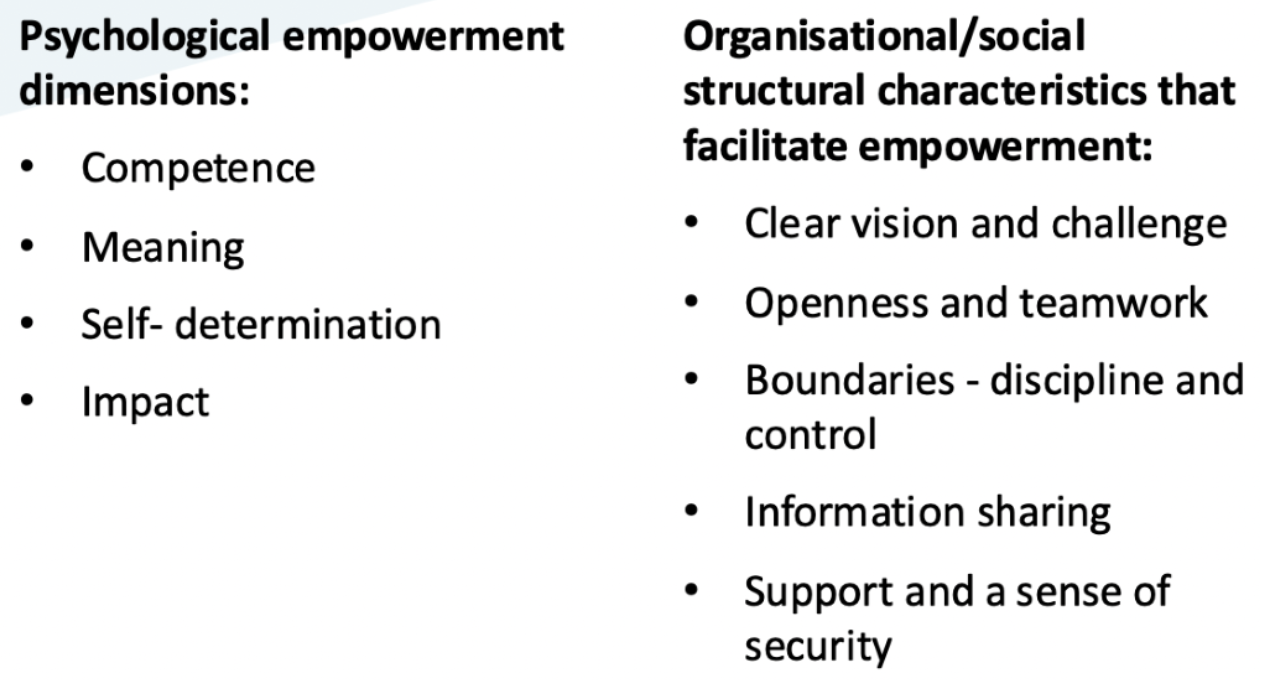
Focus: Giving employees more control over their work, decision-making, and resources.